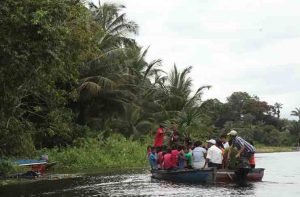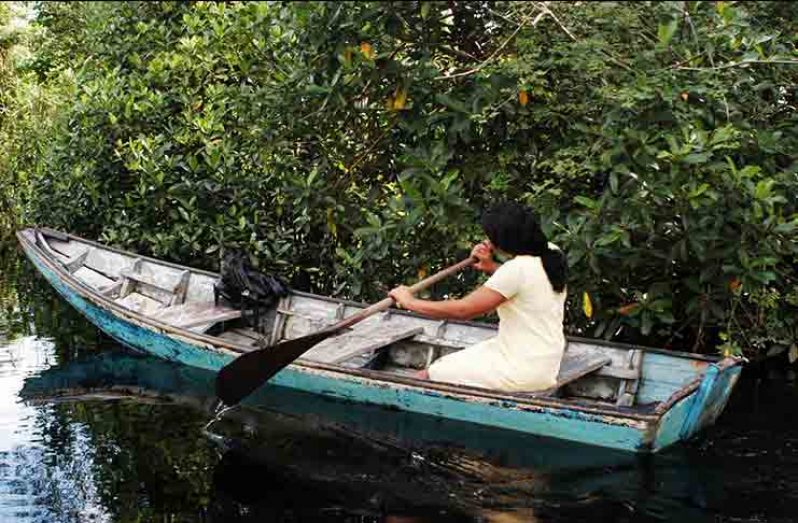– Ignored for generations, a pile of mysterious bones in the North West is now at the heart of a drive towards community-based tourism
By Faizool Deo

There is a belief that approximately a century and a half ago a whale or another big marine animal terrorised the indigenous community of Wakapoa in Region Two.
The tale might have been altered over the decades, but the consensus by the elders in the village who know the story is that it started with a young Arawak girl who found a beautiful little fish and kept it as a pet.
That animal however began to grow, so much so that her father had to make an extremely big pond to house it. From a loving pet it turned into a monster and eventually swallowed the child.The fearful villagers turned to one of their leaders for help. Armed with a blade, hot pepper and a whistle, he allowed the animal to swallow him and once inside he was able to inflict damage. Eventually with the help of the villagers he not only freed himself, but killed the creature in the process.
And that brings us to a pile of bones at Wakapao.
Since the tale was a part of the folklore, the residents of the community avoided the bones in the generations that followed.
Estimated to be around 60 feet long, it was visible for many decades until someone, out of fear, decided to chop it up some time back. Today the bones, which were once an eyesore to the community, are helping to rebrand it.
Several tourists have visited the area over the last two months. Two Canadians have actually argued that the bones (now in pieces and covered by moss) might have belonged to a dinosaur. Others believe that the animal’s remains might be thousands of years old, but until it is carbon dated by professionals, the tale remains the only source of information.
Tourists have been travelling to Wakapoa with Jessica Hatfield, the manager of Adel’s Rainforest Resort and Eco-Lodge on Akawani Creek. She has formed a working partnership with both the Wakapoa and Akawani communities.
A few months ago Jessica travelled with workers from the Ministry of Indigenous Peoples’ Affairs who were visiting the students of the Hinterland Employment Youth Service (HEYS) Programme. She was thrilled with what she saw.
“I was really excited about the HEYS project. We know what the problems are: The youths have not graduated, they don’t have their CXC. I thought this was a marvellous project. I thought this was well crafted, well thought out and well executed.”
Since she had worked with indigenous groups in the past, including a stint as a tour guide following the Pitjantjatjara, the nomadic aborigine tribe of Australia, she understood the importance of the youngsters becoming culturally empowered.
After getting the relevant permission, the South African began imparting her knowledge to some of the young adults of the communities who were already studying tourism and agriculture.
Her main objective was to give them hands-on experience and exposure. She has promised to employ several of them at the resort, but feels that they can also benefit from tourism within their community.
To date she has had stints with approximately 100 students from the HEYS programme in several part of the region and will be working with some of the communities in conjunction with the ministry to help develop community-based tourism.
In Wakapoa, where she started, one of the students told her about the bones after she had asked them to investigate what was unique about their community. She then collected 40 gallons of gas donated by Golden Brook and set off in search of the animal’s remains. She travelled with a guide who knew the location, and some children from the Ruimveldt Children’s Aid Centre (whom she treated to an adventure).

Jessica said that every time tourists travel to see the bones the community benefits. There is someone who gets paid to teach the travellers how to make cassava bread, the boat captains get paid and persons who make handicraft are able to sell their products. The resort manager added that the goal is to have as many persons as possible involved by implementing different projects.
Along with the Akawani community, several other areas are looking to promote their tourism, including St. Monica and Kabakaburi.
“Everybody wants this (to develop tourism), and each one of them (the communities) has an individual story, each one of them has a different draw.”
Some of the areas are naturally beautiful; some are teeming with wildlife, while others have history, like the petroglyphs and shell mounds of Kabakaburi.
In Wakapoa the bones have since created a sense of pride. And some persons believe that there are other big bones in the area, but perhaps those are underground.
Finding bones is not the only way that the community is keeping the story alive.
One of the older women claims to know the song that the little girl used to sing to the fish. She said it was passed down over the ages.
She is now teaching the song and story to youngsters in the community with the hope of them passing on the legend of the girl and the sea creature to the next generation of villagers.


.jpg)











